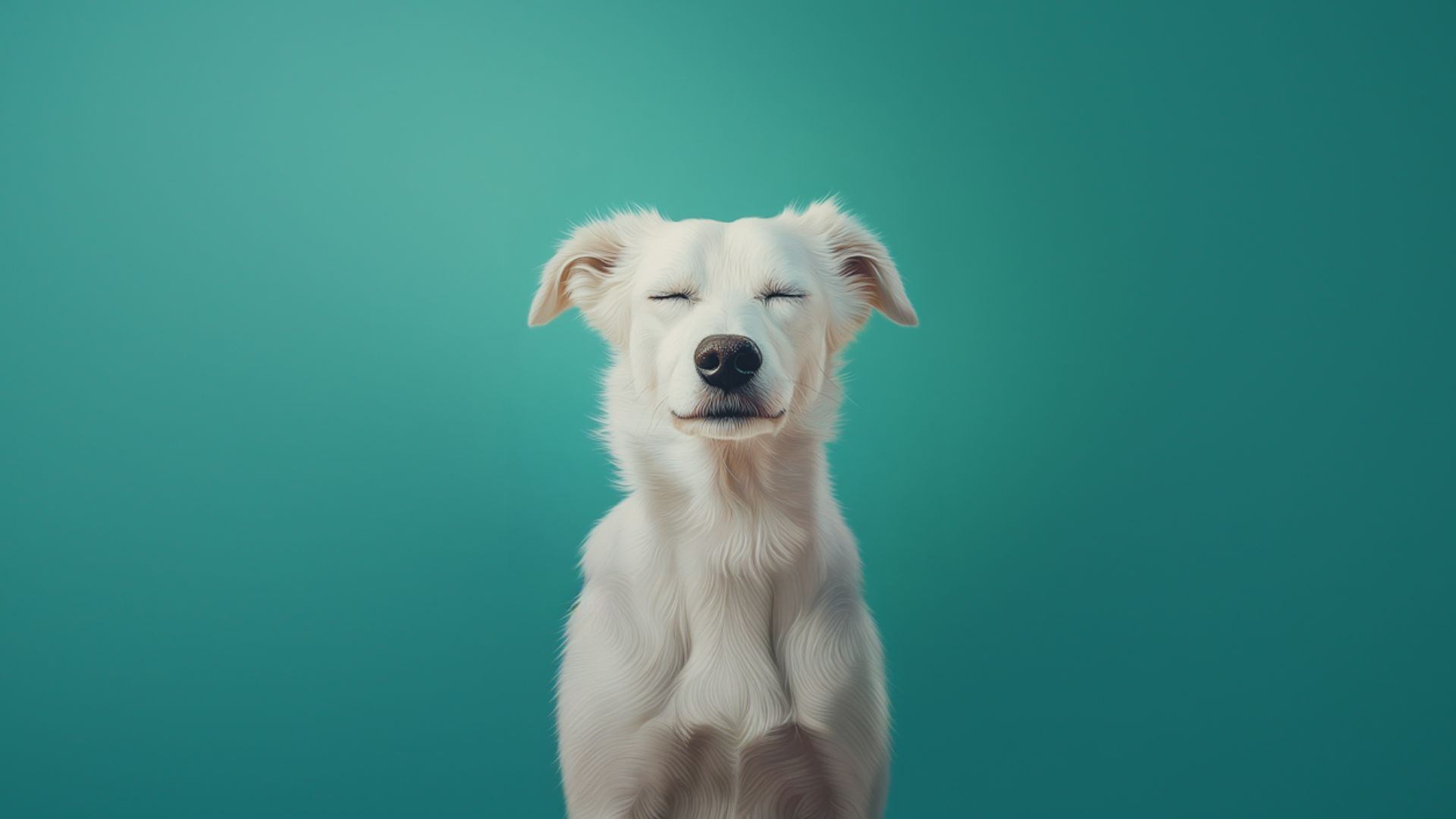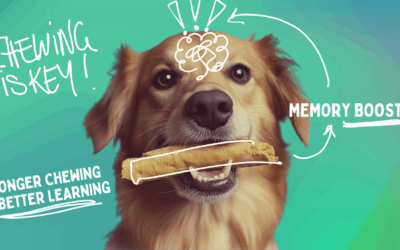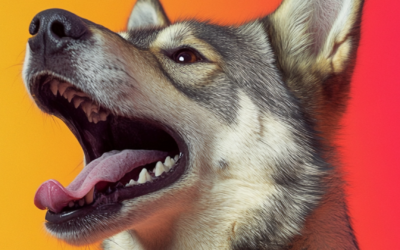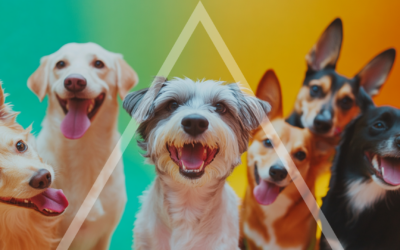If you blink, I’ll blink back! The role of eye blinking in canine communication
Highlights
Dogs may blink to communicate
Nose licking does not trigger the same response
Blinking could help dogs maintain social bonds and reduce conflict
Male dogs lick their noses more than females
Dogs, like primates, may synchronize blinks

Let’s break down the science
behind the findings
We know that subtle facial expressions—like smiling and blinking—play a key role in human social interactions. But have you ever wondered if animals use similar signals? A new study by Canori et al. (2025) reveals that dogs blink back when they see another dog blink. Researchers showed dogs videos of other dogs blinking, licking their noses, or maintaining a neutral expression. The results showed that dogs blinked more when watching other dogs blink, suggesting a possible form of social mimicry or synchronization.
How dogs use facial expressions to communicate
Animals, and especially dogs, are highly sensitive to small movements, quickly learning to interpret them as signals that anticipate behaviours that express intentions.
Studying these subtle signals, such as facial expressions, helps us better understand canine emotions and social interactions. Dogs communicate not just through vocalizations (like barking or whining) or macro-behaviors (like wagging tails or play bows) but also through micro-movements that can express intentions and influence social interactions.
Researchers from the Domestic Dog Ethology Lab at the University of Parma have been investigating the nature and function of these expressions, particularly self-directed displacement behaviours. These behaviours, such as yawning, nose licking, scratching, and blinking, are often seen as out of context but may serve communicative functions. Many of these signals, previously identified as appeasement or calming signals, may help reduce aggression and convey peaceful intentions to others.
Why studying subtle canine signals matters
Understanding subtle communicative signals in dogs is essential for improving human-dog interactions and enhancing our interpretation of canine behaviour.
Often, behaviors like blinking, nose licking, or yawning are misinterpreted as signs of stress or frustration. While these behaviours can indeed be related to arousal, they may also serve a social purpose, helping dogs to communicate with their peers and avoid conflicts. Recognizing the social function of these signals can prevent misinterpretations and improve communication between humans and dogs. But how can we study the function of these singular behaviours?
How researchers studied canine facial expressions
Since dogs rely on multiple forms of communication—olfactory, proxemic (body positioning), vocal, and chemical—isolating the function of specific visual signals can be challenging.
To study this, researchers designed an experiment where 54 pet dogs watched video recordings of other dogs displaying different facial expressions. The dogs were exposed to three conditions:
- Neutral expression: A dog attentively gazing at a toy or food reward.
- Blinking: A dog exhibiting slow eye blinks.
- Nose licking: A dog licking its nose.
Each test dog was placed in a small room, held on a leash by their owner, and watched the videos projected onto a screen. Researchers then recorded their responses using multiple cameras and analyzed their behaviour using the DogFACS coding system. Additionally, heart rate measurements were taken with a Polar belt to assess arousal levels.
The key behaviours analyzed included:
- Self-directed displacement behaviours: Blinking, nose licking, yawning, and other self-directed signals.
- Facial expressions: Movements of the mouth (e.g., nose wrinkling, lip corner pulling, tongue or teeth showing) and ear movements (e.g., ear rotation, flattening, or lowering).
The goal was to determine whether dogs respond differently to specific visual signals, indicating a potential communicative function.
Key findings: What dogs’ blinking behaviour reveals
-
- Blinking elicits a response in other dogs
Dogs were more likely to blink back when they saw a conspecific blink in the video, suggesting that blinking serves a communicative function. This reciprocity indicates that dogs may use blinking as a way to convey non-aggressive intentions and maintain social cohesion.
- Blinking elicits a response in other dogs
-
- Nose licking did not trigger the same effect
Unlike blinking, nose licking did not lead to an increase in nose licking responses from the watching dogs. This suggests that nose licking might not serve the same communicative role as blinking.
- Nose licking did not trigger the same effect
-
- Male dogs lick their noses more than females
Interestingly, male dogs exhibited nose licking behavior more frequently than females. Previous studies have found that male dogs are more likely to engage in behaviours related to social dominance, aggression, and territorial defense. This higher frequency of nose licking could be linked to intra-sexual competition or social signalling within canine groups.
- Male dogs lick their noses more than females
-
- Evolutionary insights: Blinking as a social signal
Eye blinking is not unique to dogs—primates, including humans and rhesus macaques, also synchronize their blinks during social interactions. This suggests that blinking serves a function beyond basic eye protection.
- Evolutionary insights: Blinking as a social signal
In dogs, blinking has previously been considered an appeasement behaviour, used to signal peaceful intentions to conspecifics and humans. This study provides the first evidence that reciprocal blinking occurs between dogs, reinforcing the idea that it plays a role in non-verbal communication. It may help dogs strengthen social bonds, reduce tension, and communicate non-aggressive intentions within a group.
How can you use this knowledge?
Understanding canine facial expressions can enhance our interactions with dogs, helping us interpret their emotions and intentions more accurately. Recognizing blinking as a communicative signal rather than a reflexive action allows for better interpretation of dog-dog and dog-human interactions.
These findings also open the door for further research into the timing and contexts in which reciprocal blinking occurs. Could it be a form of social mimicry? Does it play a role in specific social interactions, such as play or conflict resolution? Future studies will need to explore these questions in more detail.
Conclusion
This study is the first to provide evidence that reciprocal blinking occurs in dogs, suggesting its role in intraspecific communication. While nose licking did not elicit the same response, blinking appears to be a social signal that influences canine interactions.
Understanding these subtle communicative behaviours helps us better interpret dog behaviour, reducing miscommunication and improving both human-dog and dog-dog relationships. Further research will clarify how blinking fits into the broader framework of canine social signalling and whether it can be considered a form of social contagion or mimicry.
By learning to recognize and respect these signals, we can foster more harmonious relationships with our canine companions and improve their welfare in both domestic and social settings.
Put the science into practice
How to apply these findings in everyday life
Try blinking at your dog
A simple way to test your dog’s response is to blink slowly at them and see if they blink back. If they do, it may be a sign of trust and connection.
Blinking as a social signal
If your dog blinks at you or another dog, it could indicate a friendly and relaxed state. This small signal might help reduce tension and promote positive interactions.
Context matters for nose licking
While often associated with stress, nose licking can also have a social function. Instead of assuming your dog is anxious, consider the overall situation before drawing conclusions.
Strengthen your bond through observation
Paying attention to subtle signals like blinking and facial expressions can help you better understand your dog’s emotions. This awareness enhances your ability to respond appropriately and build a stronger relationship.
Use blinking to comfort your dog
If your dog seems uneasy, try blinking slowly to reassure them. It’s a gentle way to signal that everything is okay and may help them feel more at ease.
Recognise blinking in dog-to-dog interactions
When dogs meet, observe if they blink at each other. Reciprocal blinking might indicate a peaceful, non-threatening exchange, helping you assess their interaction.
Cite this paper summary as:
Dogs and Science (2025): If you blink, I’ll blink back! The role of eye blinking in canine communication (www.dogsandscience.com)
Publication:
Canori C, Travain T, Pedretti G, Fontani R, Valsecchi P. 2025. If you blink at me, I’ll blink back. Domestic dogs’ feedback to conspecific visual cues. R. Soc. Open Sci. 12: 241703. https://doi.org/10.1098/rsos.241703
Feedback
At dogsandscience, we are always looking for ways to improve and provide the best experience for our customers. Your feedback is incredibly important to us, as it helps us understand what we’re doing well and where we can do better. Whether you have suggestions, comments, or simply want to share your thoughts, we truly appreciate your input. Every piece of feedback helps us grow and serve you better. Thank you for taking the time to share your experience with us!
Downloads
Get the PDF Version of this article:
Sign up and get our free Tool:
You have already signed up to our list? Enter your Passwort below and download the Tool.
Sign up to get your free Tool!
Subscribe to our newsletter to stay updated and get access to our exclusive Download Area.
Don’t miss out on important insights and discoveries about our canine companions!
After you have subscribed, you will receive an e-mail with your access to the download area.
More Content on Social Media:
You have already signed up?
Get our free Tool now.
Enter the passwort we’ve send you in an e-mail or go to the login area where you can download the tool and other free content.



